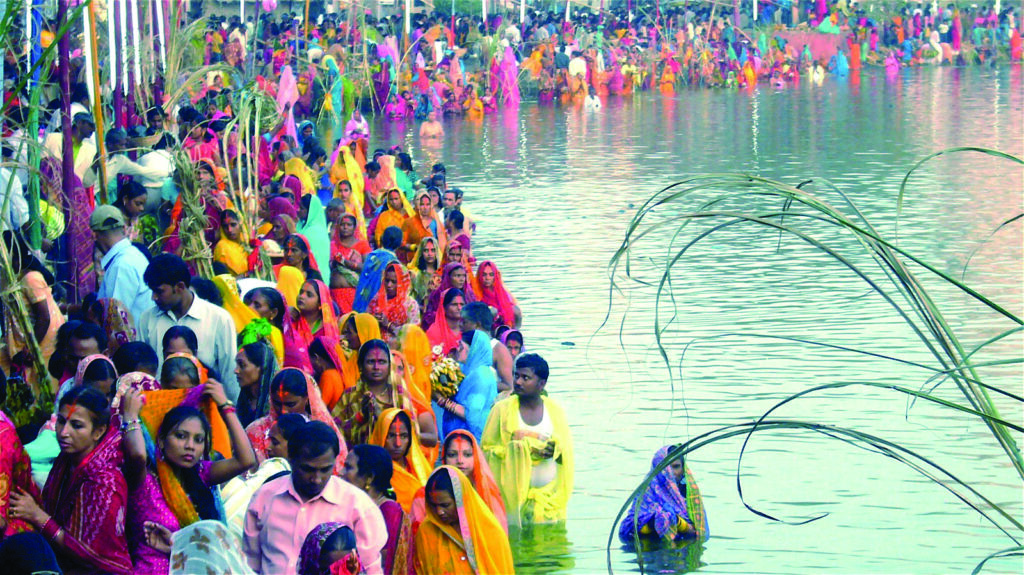
Chhath Puja is one of the most revered Hindu festivals celebrated primarily in the Indian states of Bihar, Jharkhand, Uttar Pradesh, and in some parts of Nepal. This ancient and unique festival is dedicated to worshipping the Sun God, Surya, and his consort Usha, also known as Chhathi Maiya. Chhath Puja is marked by stringent rituals, fasting, and deep reverence for nature. It spans four days of intense devotion and discipline, symbolizing the connection between humans and nature and the importance of the Sun as a life-sustaining force. The festival is also a celebration of community and unity, bringing together people of all backgrounds in rural and urban landscapes alike.
The origins of Chhath Puja are believed to be ancient, with references to Sun Yes, Chhath Puja is celebrated shortly after Diwali. Typically, it takes place on the sixth day after Diwali, which falls in the month of Kartika (around late October to early November) according to the Hindu lunar calendar.
This timing links the two festivals, as Diwali is a time of light and prosperity, while Chhath Puja is a more austere celebration focusing on devotion, purification, and gratitude to the Sun God for sustaining life on Earth.worship dating back to the Vedic period. In the Rigveda, the Sun is considered a powerful deity, often praised for bestowing life, energy, and prosperity upon the world. This worship is also rooted in Hindu mythology, with links to legendary figures such as Karna and Draupadi from the epic Mahabharata. Karna, the son of Surya, was said to worship the Sun daily, which gave him strength, power, and a radiant persona. The Pandavas, including Draupadi, are also believed to have performed rituals similar to Chhath Puja to seek blessings and prosperity for their kingdom. Another prominent legend associated with Chhath Puja is that of King Priyavrat and his wife Malini, who performed the ritual under the guidance of Maharishi Kashyap to be blessed with a child. Though the child was stillborn, the couple was saved by Chhathi Maiya, who blessed them with a healthy child. This story highlights the spirit of Chhath Puja as a festival of faith, resilience, and divine grace.
The four-day celebration of Chhath Puja involves a series of rituals that gradually increase in devotion and intensity. Each day has its own significance, contributing to the holistic experience of the festival. The first day is known as Nahay Khay, which means to bathe and eat. Devotees start the day with a ritual bath in a river or a pond, symbolizing the purification of both body and mind. After the bath, they prepare a simple vegetarian meal, often consisting of rice, lentils, and pumpkin, which they eat as prasad. This meal is prepared without onions or garlic to maintain purity, and it marks the beginning of the four-day purification process.
The second day is known as Lohanda or Kharna. On this day, devotees observe a day-long fast, abstaining from food and water. In the evening, they break their fast with a meal of kheer, a sweet rice pudding, served with chapatis and bananas. This prasad is shared with family, friends, and neighbors, symbolizing the spirit of sharing and community. After this meal, devotees begin a 36-hour fast without water, which they maintain until the final rituals are completed on the fourth day.
The third day of Chhath Puja is the most significant. It involves the evening offering to the setting Sun, known as Sandhya Arghya. Devotees, dressed in traditional attire, gather at riverbanks, ponds, or any available water bodies to offer their prayers and gratitude to the Sun God. Standing waist-deep in water, they hold baskets of offerings, including fruits, sweets, and vegetables, which they present as arghya. The sight of devotees assembled along the river, singing hymns and folk songs dedicated to the Sun and Chhathi Maiya, creates a serene and spiritual atmosphere. This ritual is a powerful visual representation of humility, gratitude, and the communal aspect of Chhath Puja.
The final day of Chhath Puja involves the morning offering, known as Usha Arghya, to the rising Sun. Devotees gather before dawn to make this offering, completing the cycle of worship that began with the setting Sun. The morning arghya symbolizes the renewal of energy and the completion of the fasting period. After the offering, devotees break their fast by consuming prasad, which they share with family and friends, spreading blessings, and concluding the festival with joy and gratitude.

The significance of Chhath Puja lies in its unique focus on nature worship. Unlike most Hindu festivals, which involve elaborate idols and temple ceremonies, Chhath Puja is observed in natural settings, bringing devotees closer to the earth and water. The Sun, regarded as the ultimate source of life, is worshipped directly without any intermediary, reflecting an unmediated and humble relationship with the divine. The fasting observed during Chhath Puja is also one of the strictest in Hindu culture, as devotees abstain from food and water for extended periods. This discipline is believed to purify the body and mind, preparing devotees to receive divine blessings. Many believe that worshipping the Sun during Chhath Puja can remove toxins from the body, enhance mental clarity, and improve physical health.
Chhath Puja’s rituals embody core Hindu beliefs about harmony with nature. The festival involves a deep reverence for the natural elements and emphasizes cleanliness, purity, and humility. The offerings are made from eco-friendly materials such as bamboo baskets, clay lamps, and organic fruits, all of which are biodegradable and do not harm the environment. This is particularly important today as the festival has grown in popularity and is celebrated in increasingly urbanized areas. Devotees are encouraged to maintain cleanliness at ghats and water bodies, ensuring that these natural resources remain pure for future generations. In cities, local administrations often set up eco-friendly ghats and waste management facilities to support sustainable practices during Chhath Puja.
Chhath Puja is not only a spiritual and ecological festival but also a cultural one that fosters a sense of unity and togetherness. Communities, both rural and urban, come together to celebrate, creating a shared experience that strengthens social bonds. Friends, family members, and neighbors support one another in preparing for the rituals, arranging facilities, and distributing prasad. This communal spirit is one of the most cherished aspects of Chhath Puja, reflecting the collective ethos of Indian society. Folk songs, often led by women, play a significant role in the festival, adding to the cultural richness of the occasion. These songs, sung in regional languages like Bhojpuri, Maithili, and Magahi, are passed down through generations and capture the emotional and spiritual essence of Chhath Puja. In recent years, Chhath Puja has gained prominence across India and even internationally. Migrants from Bihar, Uttar Pradesh, and Jharkhand have taken the festival to cities such as Mumbai, Delhi, and Kolkata, where it is celebrated with as much enthusiasm as in their native regions. This spread of Chhath Puja highlights the resilience of tradition in a changing world. Even in foreign countries such as the United States and the United Kingdom, Indian communities gather to celebrate Chhath Puja at rivers, lakes, and other water bodies, preserving their cultural heritage and bringing a piece of home with them. The festival has also received increased media attention and social media presence, with people sharing photos and videos of the rituals online. This digital platform not only helps spread awareness of the festival but also connects devotees worldwide, allowing them to participate in the celebrations from afar.

Chhath Puja in modern times has adapted to the urban environment while retaining its core values. The emphasis on eco-friendly practices has become more pronounced as devotees recognize the need to protect the environment in which they worship. Campaigns to reduce plastic use and waste during Chhath Puja have been organized by environmental groups, local administrations, and community leaders. These efforts aim to preserve the purity of rivers, ponds, and other water bodies, ensuring that the festival remains harmonious with nature. The communal aspect of Chhath Puja has also grown, as urban neighborhoods often come together to arrange public facilities for the rituals, strengthening social bonds and reinforcing a sense of shared responsibility.
In conclusion, Chhath Puja is more than a festival; it is a celebration of life, nature, and the human connection to the cosmos. Through its rituals of purification, fasting, and devotion, Chhath Puja reflects a profound respect for the natural elements that sustain life. The Sun is worshipped as a source of energy, health, and prosperity, with devotees expressing gratitude and seeking blessings for themselves and their families. Chhath Puja’s emphasis on environmental sustainability and community values makes it relevant in today’s world, where the importance of conserving nature and fostering unity cannot be overstated. As Chhath Puja continues to grow in popularity and spread to new regions, it remains a powerful reminder of the resilience of tradition and the enduring bond between humans and the natural world.















